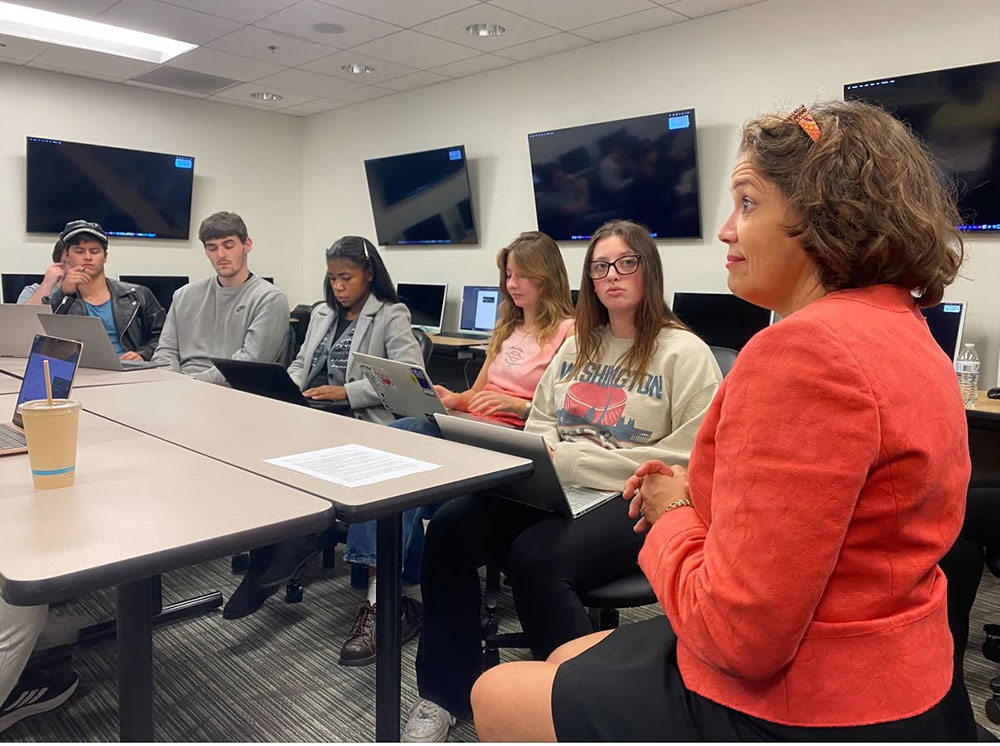Loyola students report on vacant housing crisis for Baltimore Fishbowl

Articles written by journalism capstone students at Loyola University Maryland exploring the issue of vacant housing in Baltimore have been featured in a series in Baltimore Fishbowl. In their reporting, Loyola students examined the causes and effects of the situation, as well as community-driven development efforts that aim to revitalize neighborhoods without displacement.
The series, titled "Vacants in Baltimore,” includes four stories written by Loyola students.
“This was an opportunity for young people to engage with professionals on real issues, on the ground, in the city where they’re living, in really important ways,” said April Newton, assistant teaching professor of multimedia journalism, who teaches the capstone course. “I cannot be grateful enough to the community members that were willing to help guide the students on this project and give them that high-impact learning experience that we are always after.”
Newton chose the topic of the vacant housing crisis in Baltimore for this year’s capstone project to allow students to report on a local issue and uncover stories that “maybe aren’t being told,” which led to the opportunity for the students to have their work published in Baltimore Fishbowl. The capstone project “changed the way some of the students understood journalism’s purpose, its practice, and what they’re going to do next,” said Newton.
The students spoke with community members, activists, local editors, and city officials—including Baltimore City Councilmember Odette Ramos and Housing Commissioner Alice Kennedy—to inform their reporting. The project allowed students to engage directly with sources through experiential learning.
“Reporting on local issues not only keeps the community informed but also opens our eyes about how a community needs to improve for the sake of its residents' quality of life,” said Matt McCarney, ’25. “The most important lesson I learned as a journalist from reporting on the issue of vacant homes is that finding the right source is a non-linear process. Sometimes, the first or second interview, while helpful, is not the essential source that will tell the story you want to tell. In my case, Regina Hammond of Rebuild Johnston Square Neighborhood Organization became the key source for my article published in Baltimore Fishbowl. She was the heart of my story, yet she was the third source out of four that I came into contact with during the process.”
The stories published in Baltimore Fishbowl are:
- “Rot and Renewal: The impact of vacant properties in Baltimore,” by Joe Mesa, ’25, explores the “decades of disinvestment, absentee landlords, and tangled property laws” which have “left Baltimore neighborhoods scarred by decay.”
- “Battling vacancies and addiction in Westport,” by Nathan McConarty, ’25, examines the “cascading effects” of vacant properties, including addiction.
- "After demolitions, a long wait for Tivoly eco-friendly homes,” by Jack Barker, ’24, tells the story of a stalled redevelopment project in Northeast Baltimore.
- "Johnston Square: Development without displacement,” by Matt McCarney, ’25, highlights the Rebuild Johnston Square Neighborhood Organization and the “path to revitalization without gentrification.”
About Loyola University Maryland’s Department of Communication and Media
Loyola’s Department of Communication and Media is housed in Loyola College, the University’s school of arts and sciences, which is one of the three schools within Loyola University Maryland. Founded in 2006, the department is one of the largest and most in-demand on campus. Students studying areas of the communications industry may choose specializations in advertising and public relations, digital media, journalism, or media and society. The department is home to award-winning, student-run media outlets, including WLOY Loyola Radio, Greycomm Studios, and The Greyhound weekly student newspaper. The United States’ first student-run publishing house, Apprentice House Press, also falls within the department’s domain. Clubs and additional activities the department sponsors include Loyola’s heavily decorated Public Relations Student Society of America Chapter, the AAF Chapter, the Evergreen annual yearbook, and Lambda Pi Eta Honor Society. For more information, please visit loyola.edu/communication.